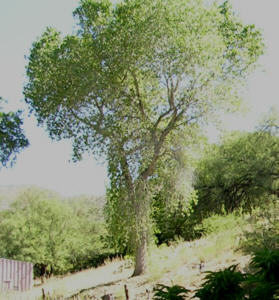|
The
American sycamore (Platanus occidentalis), also known as American
plane and Buttonwood, is one of the species of Platanus native
to North America, where it is rather confusingly very often just called
Sycamore, which can refer to other types of tree.
It forms a massive tree, typically reaching up to 30-40 metres high.
In its native range, it is often found in riparian and wetland areas.
The range extends from Iowa to Ontario and Maine in the north, Nebraska
in the west, and south to Texas to Florida. Closely related species
(see Platanus) occur in Mexico and the southwestern states of the U.S.A.
It is sometimes grown for timber, and has become naturalised in some
areas outside its native range.
American sycamore is susceptible to Plane anthracnose disease (Apiognomonia
veneta, syn. Gnomonia platani), an introduced fungus naturally
found on the Oriental plane P. orientalis, which has evolved
considerable resistance to the disease. Although rarely killed or even
seriously harmed, American sycamore is commonly partially defoliated
by the disease, rendering it unsightly as a specimen tree. As a result,
American sycamore is not often planted; the more resistant London plane
(P. x hispanica; hybrid P. occidentalis x P. orientalis)
being preferred instead.
Image © Con Englehorn - from the Coon
Creek Listing
|


